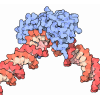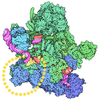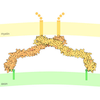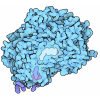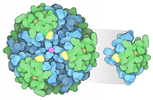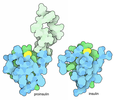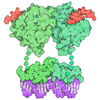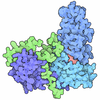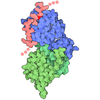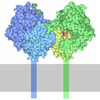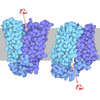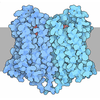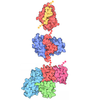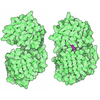[English] 日本語
 Yorodumi
Yorodumi- PDB-9i2c: Cryo-EM structure of KBTBD4 WT-HDAC2-CoREST1 2:1:1 complex mediat... -
+ Open data
Open data
- Basic information
Basic information
| Entry | Database: PDB / ID: 9i2c | |||||||||
|---|---|---|---|---|---|---|---|---|---|---|
| Title | Cryo-EM structure of KBTBD4 WT-HDAC2-CoREST1 2:1:1 complex mediated by molecular glue UM171 | |||||||||
 Components Components |
| |||||||||
 Keywords Keywords | LIGASE / E3 ligase / deacetylase / ubiquitylation / transcription / molecular glue / complex | |||||||||
| Function / homology |  Function and homology information Function and homology informationpositive regulation of male mating behavior / protein de-2-hydroxyisobutyrylase activity / protein lysine delactylase activity / negative regulation of dendritic spine development / p75NTR negatively regulates cell cycle via SC1 / epidermal cell differentiation / positive regulation of megakaryocyte differentiation / histone decrotonylase activity / fungiform papilla formation / NuRD complex ...positive regulation of male mating behavior / protein de-2-hydroxyisobutyrylase activity / protein lysine delactylase activity / negative regulation of dendritic spine development / p75NTR negatively regulates cell cycle via SC1 / epidermal cell differentiation / positive regulation of megakaryocyte differentiation / histone decrotonylase activity / fungiform papilla formation / NuRD complex / positive regulation of interleukin-1 production / regulation of cell fate specification / behavioral response to ethanol / EGR2 and SOX10-mediated initiation of Schwann cell myelination / negative regulation of transcription by competitive promoter binding / negative regulation of stem cell population maintenance / histone deacetylase activity, hydrolytic mechanism / ESC/E(Z) complex / histone deacetylase / regulation of stem cell differentiation / cardiac muscle hypertrophy / cellular response to dopamine / STAT3 nuclear events downstream of ALK signaling / DNA repair complex / response to caffeine / protein lysine deacetylase activity / Hydrolases; Acting on carbon-nitrogen bonds, other than peptide bonds; In linear amides / histone deacetylase activity / embryonic digit morphogenesis / positive regulation of intracellular estrogen receptor signaling pathway / Notch-HLH transcription pathway / Sin3-type complex / histone deacetylase complex / odontogenesis of dentin-containing tooth / eyelid development in camera-type eye / positive regulation of stem cell population maintenance / dendrite development / histone methyltransferase complex / response to amyloid-beta / RNA Polymerase I Transcription Initiation / positive regulation of oligodendrocyte differentiation / positive regulation of proteolysis / progesterone receptor signaling pathway / Regulation of MECP2 expression and activity / response to hyperoxia / hair follicle placode formation / NF-kappaB binding / FOXO-mediated transcription of oxidative stress, metabolic and neuronal genes / cellular response to transforming growth factor beta stimulus / positive regulation of epithelial to mesenchymal transition / Transcriptional regulation of brown and beige adipocyte differentiation by EBF2 / MECP2 regulates neuronal receptors and channels / Regulation of TP53 Activity through Acetylation / cellular response to retinoic acid / heat shock protein binding / transcription repressor complex / negative regulation of cell migration / SUMOylation of chromatin organization proteins / response to amphetamine / Regulation of PTEN gene transcription / ERCC6 (CSB) and EHMT2 (G9a) positively regulate rRNA expression / transcription coregulator binding / erythrocyte differentiation / Regulation of endogenous retroelements by KRAB-ZFP proteins / response to nicotine / response to cocaine / HDACs deacetylate histones / Regulation of endogenous retroelements by Piwi-interacting RNAs (piRNAs) / circadian regulation of gene expression / promoter-specific chromatin binding / negative regulation of transforming growth factor beta receptor signaling pathway / NoRC negatively regulates rRNA expression / protein modification process / NOTCH1 Intracellular Domain Regulates Transcription / histone deacetylase binding / Constitutive Signaling by NOTCH1 PEST Domain Mutants / Constitutive Signaling by NOTCH1 HD+PEST Domain Mutants / cellular response to hydrogen peroxide / positive regulation of tumor necrosis factor production / transcription corepressor activity / heterochromatin formation / negative regulation of neuron projection development / cellular response to heat / Factors involved in megakaryocyte development and platelet production / chromatin organization / histone binding / response to lipopolysaccharide / transcription regulator complex / Potential therapeutics for SARS / RNA polymerase II-specific DNA-binding transcription factor binding / chromosome, telomeric region / chromatin remodeling / response to xenobiotic stimulus / negative regulation of gene expression / negative regulation of DNA-templated transcription / positive regulation of cell population proliferation / chromatin binding / regulation of transcription by RNA polymerase II / negative regulation of apoptotic process / chromatin Similarity search - Function | |||||||||
| Biological species |  Homo sapiens (human) Homo sapiens (human) | |||||||||
| Method | ELECTRON MICROSCOPY / single particle reconstruction / cryo EM / Resolution: 3.3 Å | |||||||||
 Authors Authors | Chen, Z. / Chi, G. / Pike, A.C.W. / Montes, B. / Bullock, A.N. | |||||||||
| Funding support |  United Kingdom, United Kingdom,  Switzerland, 2items Switzerland, 2items
| |||||||||
 Citation Citation |  Journal: Nat Commun / Year: 2025 Journal: Nat Commun / Year: 2025Title: Structural mimicry of UM171 and neomorphic cancer mutants co-opts E3 ligase KBTBD4 for HDAC1/2 recruitment. Authors: Zhuoyao Chen / Gamma Chi / Timea Balo / Xiangrong Chen / Beatriz Ralsi Montes / Steven C Clifford / Vincenzo D'Angiolella / Timea Szabo / Arpad Kiss / Tibor Novak / András Herner / András ...Authors: Zhuoyao Chen / Gamma Chi / Timea Balo / Xiangrong Chen / Beatriz Ralsi Montes / Steven C Clifford / Vincenzo D'Angiolella / Timea Szabo / Arpad Kiss / Tibor Novak / András Herner / András Kotschy / Alex N Bullock /   Abstract: Neomorphic mutations and drugs can elicit unanticipated effects that require mechanistic understanding to inform clinical practice. Recurrent indel mutations in the Kelch domain of the KBTBD4 E3 ...Neomorphic mutations and drugs can elicit unanticipated effects that require mechanistic understanding to inform clinical practice. Recurrent indel mutations in the Kelch domain of the KBTBD4 E3 ligase rewire epigenetic programs for stemness in medulloblastoma by recruiting LSD1-CoREST-HDAC1/2 complexes as neo-substrates for ubiquitination and degradation. UM171, an investigational drug for haematopoietic stem cell transplantation, was found to degrade LSD1-CoREST-HDAC1/2 complexes in a wild-type KBTBD4-dependent manner, suggesting a potential common mode of action. Here, we identify that these neomorphic interactions are mediated by the HDAC deacetylase domain. Cryo-EM studies of both wild-type and mutant KBTBD4 capture 2:1 and 2:2 KBTBD4-HDAC2 complexes, as well as a 2:1:1 KBTBD4-HDAC2-CoREST1 complex, at resolutions spanning 2.7 to 3.3 Å. The mutant and drug-induced complexes adopt similar structural assemblies requiring both Kelch domains in the KBTBD4 dimer for each HDAC2 interaction. UM171 is identified as a bona fide molecular glue binding across the ternary interface. Most strikingly, the indel mutation reshapes the same surface of KBTBD4 providing an example of a natural mimic of a molecular glue. Together, the structures provide mechanistic understanding of neomorphic KBTBD4, while structure-activity relationship (SAR) analysis of UM171 reveals analog S234984 as a more potent molecular glue for future studies. | |||||||||
| History |
|
- Structure visualization
Structure visualization
| Structure viewer | Molecule:  Molmil Molmil Jmol/JSmol Jmol/JSmol |
|---|
- Downloads & links
Downloads & links
- Download
Download
| PDBx/mmCIF format |  9i2c.cif.gz 9i2c.cif.gz | 270 KB | Display |  PDBx/mmCIF format PDBx/mmCIF format |
|---|---|---|---|---|
| PDB format |  pdb9i2c.ent.gz pdb9i2c.ent.gz | Display |  PDB format PDB format | |
| PDBx/mmJSON format |  9i2c.json.gz 9i2c.json.gz | Tree view |  PDBx/mmJSON format PDBx/mmJSON format | |
| Others |  Other downloads Other downloads |
-Validation report
| Summary document |  9i2c_validation.pdf.gz 9i2c_validation.pdf.gz | 1.6 MB | Display |  wwPDB validaton report wwPDB validaton report |
|---|---|---|---|---|
| Full document |  9i2c_full_validation.pdf.gz 9i2c_full_validation.pdf.gz | 1.6 MB | Display | |
| Data in XML |  9i2c_validation.xml.gz 9i2c_validation.xml.gz | 53.2 KB | Display | |
| Data in CIF |  9i2c_validation.cif.gz 9i2c_validation.cif.gz | 79 KB | Display | |
| Arichive directory |  https://data.pdbj.org/pub/pdb/validation_reports/i2/9i2c https://data.pdbj.org/pub/pdb/validation_reports/i2/9i2c ftp://data.pdbj.org/pub/pdb/validation_reports/i2/9i2c ftp://data.pdbj.org/pub/pdb/validation_reports/i2/9i2c | HTTPS FTP |
-Related structure data
| Related structure data |  51336MC  9gglC  9ggmC  9ggnC M: map data used to model this data C: citing same article ( |
|---|---|
| Similar structure data | Similarity search - Function & homology  F&H Search F&H Search |
- Links
Links
- Assembly
Assembly
| Deposited unit | 
|
|---|---|
| 1 |
|
- Components
Components
| #1: Protein | Mass: 58208.742 Da / Num. of mol.: 2 Source method: isolated from a genetically manipulated source Source: (gene. exp.)  Homo sapiens (human) / Gene: KBTBD4, BKLHD4 / Cell line (production host): Expi293F / Production host: Homo sapiens (human) / Gene: KBTBD4, BKLHD4 / Cell line (production host): Expi293F / Production host:  Homo sapiens (human) / References: UniProt: Q9NVX7 Homo sapiens (human) / References: UniProt: Q9NVX7#2: Protein | | Mass: 55443.156 Da / Num. of mol.: 1 Source method: isolated from a genetically manipulated source Source: (gene. exp.)  Homo sapiens (human) / Gene: HDAC2 / Cell line (production host): Expi293F / Production host: Homo sapiens (human) / Gene: HDAC2 / Cell line (production host): Expi293F / Production host:  Homo sapiens (human) Homo sapiens (human)References: UniProt: Q92769, histone deacetylase, Hydrolases; Acting on carbon-nitrogen bonds, other than peptide bonds; In linear amides #3: Protein | | Mass: 22231.699 Da / Num. of mol.: 1 Source method: isolated from a genetically manipulated source Source: (gene. exp.)  Homo sapiens (human) / Gene: RCOR1, KIAA0071, RCOR / Cell line (production host): Expi293F / Production host: Homo sapiens (human) / Gene: RCOR1, KIAA0071, RCOR / Cell line (production host): Expi293F / Production host:  Homo sapiens (human) / References: UniProt: Q9UKL0 Homo sapiens (human) / References: UniProt: Q9UKL0#4: Chemical | ChemComp-A1ACV / ( | Mass: 453.542 Da / Num. of mol.: 1 / Source method: obtained synthetically / Formula: C25H27N9 / Feature type: SUBJECT OF INVESTIGATION #5: Chemical | ChemComp-ZN / | Has ligand of interest | Y | Has protein modification | N | |
|---|
-Experimental details
-Experiment
| Experiment | Method: ELECTRON MICROSCOPY |
|---|---|
| EM experiment | Aggregation state: PARTICLE / 3D reconstruction method: single particle reconstruction |
- Sample preparation
Sample preparation
| Component | Name: KBTBD4 WT-HDAC2-CoREST1 2:1:1 complex mediated by molecular glue UM171 Type: COMPLEX / Entity ID: #1-#3 / Source: RECOMBINANT | ||||||||||||||||||||||||||||||
|---|---|---|---|---|---|---|---|---|---|---|---|---|---|---|---|---|---|---|---|---|---|---|---|---|---|---|---|---|---|---|---|
| Molecular weight | Experimental value: NO | ||||||||||||||||||||||||||||||
| Source (natural) | Organism:  Homo sapiens (human) Homo sapiens (human) | ||||||||||||||||||||||||||||||
| Source (recombinant) | Organism:  Homo sapiens (human) Homo sapiens (human) | ||||||||||||||||||||||||||||||
| Buffer solution | pH: 7.5 | ||||||||||||||||||||||||||||||
| Buffer component |
| ||||||||||||||||||||||||||||||
| Specimen | Conc.: 0.4 mg/ml / Embedding applied: NO / Shadowing applied: NO / Staining applied: NO / Vitrification applied: YES | ||||||||||||||||||||||||||||||
| Vitrification | Instrument: FEI VITROBOT MARK IV / Cryogen name: ETHANE / Humidity: 100 % / Chamber temperature: 277.15 K |
- Electron microscopy imaging
Electron microscopy imaging
| Experimental equipment |  Model: Titan Krios / Image courtesy: FEI Company |
|---|---|
| Microscopy | Model: TFS KRIOS |
| Electron gun | Electron source:  FIELD EMISSION GUN / Accelerating voltage: 300 kV / Illumination mode: FLOOD BEAM FIELD EMISSION GUN / Accelerating voltage: 300 kV / Illumination mode: FLOOD BEAM |
| Electron lens | Mode: BRIGHT FIELD / Nominal magnification: 105000 X / Nominal defocus max: 3200 nm / Nominal defocus min: 1000 nm / C2 aperture diameter: 50 µm |
| Specimen holder | Cryogen: NITROGEN |
| Image recording | Electron dose: 38 e/Å2 / Film or detector model: GATAN K3 BIOCONTINUUM (6k x 4k) / Num. of grids imaged: 1 / Num. of real images: 12732 |
| Image scans | Width: 5760 / Height: 4092 |
- Processing
Processing
| EM software | Name: PHENIX / Version: 1.20.1_4487: / Category: model refinement | ||||||||||||||||||||||||
|---|---|---|---|---|---|---|---|---|---|---|---|---|---|---|---|---|---|---|---|---|---|---|---|---|---|
| CTF correction | Type: PHASE FLIPPING AND AMPLITUDE CORRECTION | ||||||||||||||||||||||||
| Particle selection | Num. of particles selected: 13588054 | ||||||||||||||||||||||||
| Symmetry | Point symmetry: C1 (asymmetric) | ||||||||||||||||||||||||
| 3D reconstruction | Resolution: 3.3 Å / Resolution method: FSC 0.143 CUT-OFF / Num. of particles: 105484 / Symmetry type: POINT | ||||||||||||||||||||||||
| Atomic model building | B value: 85.1 / Protocol: FLEXIBLE FIT Details: Initial local fitting was done using Chimera. Then Coot and Phenix were used for model refinement and validation. | ||||||||||||||||||||||||
| Atomic model building |
| ||||||||||||||||||||||||
| Refine LS restraints |
|
 Movie
Movie Controller
Controller





 PDBj
PDBj
